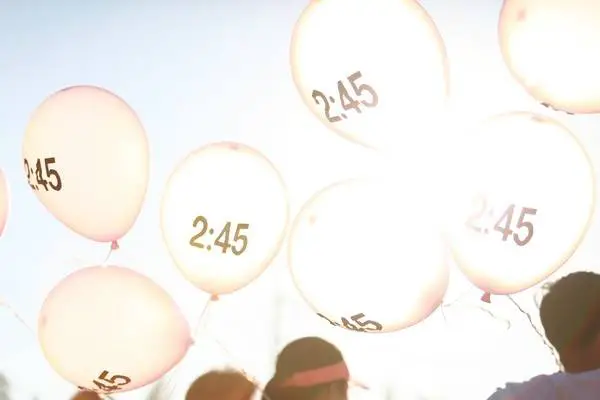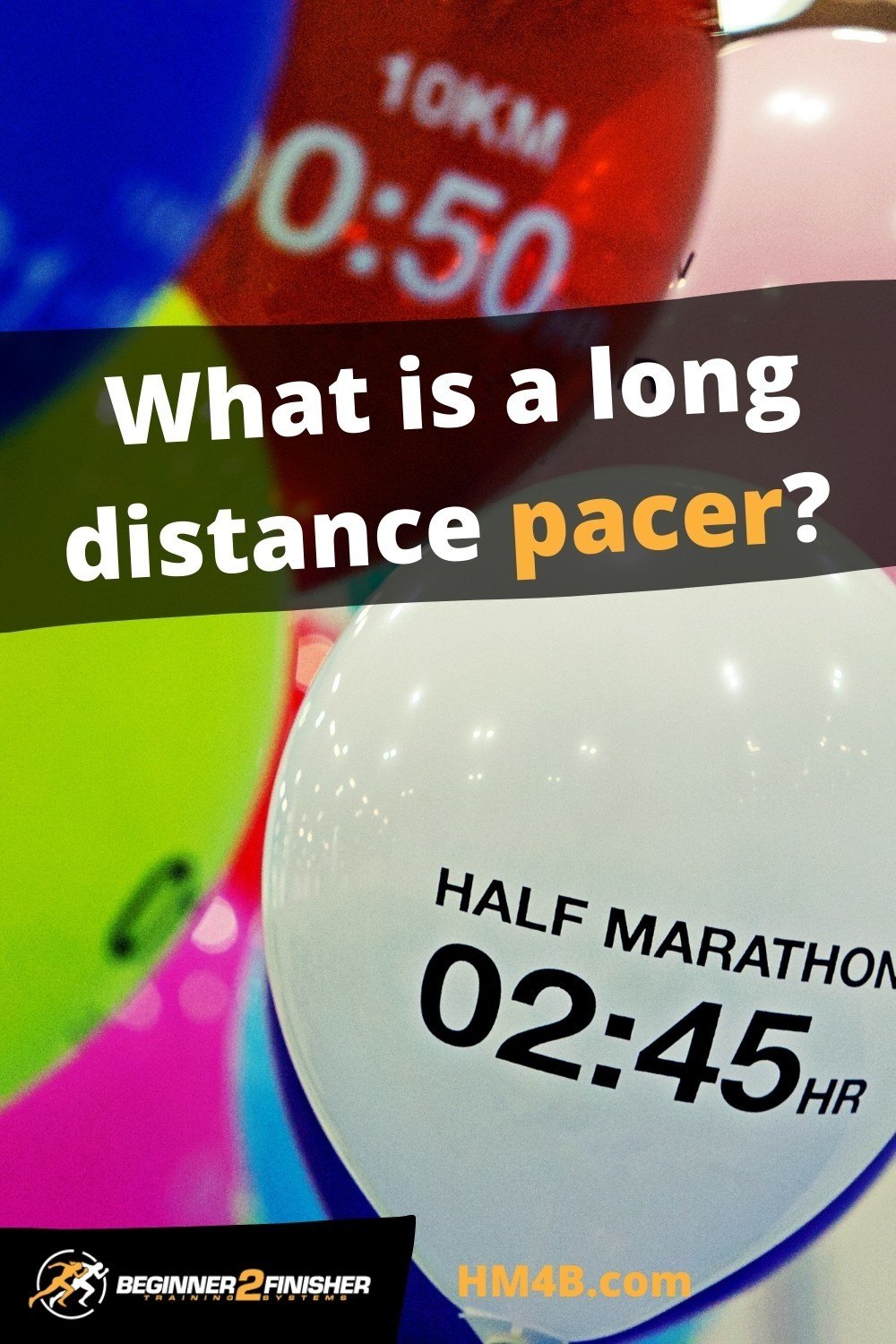Taking on a first-time marathon is a huge step in a runner’s career and it should be taken following a well-disciplined training schedule. A complete marathon training cycle can take anywhere from 16 to 24 weeks depending on the level of physical fitness you’re in. Come marathon race day, new runners (and elite runners as well) need every little bit of extra help they can gain to make it to the marathon finish line. One particular race-day aide that is a first-time marathoner game-changer is a volunteer pacer.
What exactly is marathon pacer and what do they do?
A marathon or half marathon pacer is a volunteer runner that runs a race at a specific pace for a target finish time. Pacers are usually veteran runners that have racing and pacing strategies they have mastered which they utilize during the course of the race. Pacers wear some type of signage/object such as a sign, balloon, or shirt identifying their target finish time.
Runners that need a little extra help during the course of a race can run alongside a marathon pacer that is targeting their target finish time.
Should I follow a marathon pacer during a race?
Deciding to run with or without a marathon or half marathon pacer during a race is a matter of preference. Some runners swear that their marathon pacer is the only reason they were able to finish a marathon at a targeted finish time. While on the other hand, some runners simply just want to finish a race and don’t want any added pressure to their marathon race. Here are some advantages and disadvantages of running with a marathon or half marathon pacer:
Disadvantages of running with a pacer:
Your pacer has a different running strategy
this can be a real letdown and discouragement if your pacer and yourself have different running strategies. Let’s say that you are planning on using a run/walk strategy for the majority of your marathon race. On race day you talk to the pacer assigned to your finish time and you find out that they plan on running it nonstop. Well, this can change things up drastically if you trained with a run/walk strategy. Another situation that is a hit or miss with pacers is if they plan on walking or running through the water aide station. Although this isn’t a big difference, it’s still slightly skewing things a bit that could mess with you mentally while tackling the marathon.
For a detailed dive into the run/walk method of running, check out this post:
How to use the Run/Walk Method – A Complete Guide
What your pacer told you at the beginning was nothing like what actually happened
We are all human including volunteer pacers. Sometimes even 30 and 40 marathon race veterans have to change things up because of a situation with themselves, weather, and/or the racecourse. You have to remain flexible when you use a marathon or half marathon pacer and have faith that they will hopefully get you close to your target finish time.
Possibility of slowing you down at the end
When you’re coming into the last couple of miles at a race a pacer could intentionally slow down a bit to keep on pace. However, the last few miles, if you have the energy, could be a good point to rev up your feet and increase your pace slightly. Who knows you might beat your target marathon finish time by a few seconds or maybe a minute. That’s why it’s a good idea to keep an eye on pacing via your smartwatch when you’re getting towards the end of the race.
Advantages of running with a pacer:
Less Watch Checking
When you’re following an expert such as a pacer you’ll have to spend less time worrying about checking your watch for your current pace. This helps lift some of the stress of your shoulders. Still make it a point to check your pace at least at each mile just to make sure you’re on target for your finish time.
Encourages racers
Most volunteer pacers are there to help other get to their target finish time plus they love running and the challenges that go along with it. If your a first-time marathoner and you plan on using a pacer, get to the race early enough to chat with the pacer. Most love giving advice about their racing strategy for the current race.
Posse effect helps bolster running
Just like a running club can help you reach your goals by running in grouped running activities, the pacer will also have an entourage or posse that will be surrounding them for the duration of the run. Even though we all might lose some motivation somewhere along the way during a marathon race, your posse can help you refocus and turn lost motivation into determination.
volunteers pacers usually know the course well
More than likely your volunteer pacer has run this course before. They know where to turn up the heat and push through specific parts of the race and also they know when to pull back and converse energy. They’ll also have some sort of strategy for hills. Not all pacers will have the same strategy for hills as other runners so remember: what goes up the hill must come down the hill. If you don’t agree with their hill strategy then simply meet them on the other side.
Do Pacers Run The Whole Marathon?
There two types of marathon pacers. The pacers that the elites use, the pro pacers or pacemakers, and the pacers that the rest of the racing body uses, the completion pacer.
Pro Pacer
The pro pacers are usually compensated runners that have a track record of running a specific distance at a specific pace. They start out in the front of the pack of racers and set a fast steady tempo pace until about the halfway mark of the marathon (somewhere between 10 and 14 miles depending on the race. The pro pacer does not finish the race and exits out of the race well before it’s over.
Completion Pacer
The completion pacer, or just pacer, are usually volunteer racers that can consistently sustain a specific pace for the length of the race. Some completion pacers are compensated in some form of money or free entry into the specific race. They have proven track records that show that they consistently finish within a narrow window of time (i.e. 4 hours 30 minute finish time). They tend to range from 3 hours up to 6 or even 7 hours finish time. The completion pacer runs the entire marathon so that you can have a chance to tag along and finish within the time window that the specific pacer is shooting for.
Are There Marathon Pacer Rules?
While rules for pacers don’t exist normally at the half marathon and marathon level, they do exist and a lot of the ultramarathon runs. Pacers are strictly enforced in many 100-mile duration runs. Here are some of the rules for pacers (according to the Western States 100 mile endurance race):
- Pacers may not carry water, food, flashlights, shoes, clothing, or other supplies for their runner
- Pacers also can’t provide any other type of mechanical or physical assistance to their runner on the course.
- Muling is expressly forbidden. (muling is carrying a runner’s supplies during a race)
- Pacers may carry their own supplies and food.
Are there pacers in half marathon races?
I have personally raced 6 half marathons and while all of them did have pacers at least 3 of them did. There are usually fewer pacers because it’s half the distance of a marathon. The finish times for pacers usually look something like this:
- 1:30
- 1:45
- 2:00
- 2:15
- 2:30
- 2:45
- 3:00
- 3:15
- 3:30
Sometimes they just mark the pacers at 1:30, 2:00, 2:30, and 3:00 depending on the size of the race and how many pacers they can find that will volunteer.
How do you become a running Pacer?
Big marathon races usually have several people that they can ask to run as a pacer. The pacer normally gets free race entry and all of the perks that go along with finishing the race such as the medal, finisher T-Shirt, food, and drinks, etc. In order to volunteer as a pacer, you normally have to provide some type of racing history/credentials that show you can sustain a specific pace for the complete distance of the race. The race committee might also require that the pacer’s last race be within a specific amount of time in comparison to the race they wish to pace for such as within 6 months.
Are you looking for a great way to display your medals? Check out the post I wrote reviewing the 9 best medal display hangers for runners.
Do Pacers get paid to participate in a marathon?
Completion pacers, are normally there to help other runners complete a race at a specific finish time. Rarely do completion pacers get paid to race in the event outside of free entry and free post-race swag.
Pro Pacers, or informally “rabbits”, will get some type of compensation for participating in the race. These pro pacers are just that – professional racers, that compete in racing for prize monies and awards.

How many pacers are there at a marathon?
The total amount of pacers that participate depends totally on the size of the race and how many pacers volunteer for the race. In general, a marathon has roughly between 10 and 16 volunteer pacers starting out in different corals. Sometimes the race committee spreads out the pacers in increments of 15 minutes or increments of 30 minutes. Marathon pacers run at target finish times such as the following:
- 2:45
- 3:00
- 3:15
- 3:30
- 3:45
- 4:00
- 4:15
- 4:30
- 4:45
- 5:00
- 5:15
- 5:30
- 5:45
- 6:00
Some elite races might have pacers that target a finish time as soon as 2:30 (two hours 30 minutes) and as long as 7:00 (7 hours). Most marathon pacing finish times revolve around the Boston Marathon qualifying times in 2020. Runners ages 18-34 had to finish under 3:00 (3 hours) in 2020 to qualify for the Boston Marathon.
What do pacers wear at a marathon or half marathon race?
Pacers are usually uniquely marked somehow with a specific color shirt and/or racing hat. They usually have the finish time marked on their shirts (Sometimes front and gack). I’ve actually seen a pacer mark the time on their forehead and the back of their neck (at least I’m hoping that wasn’t a tattoo).
Some racers and/or race committees require the runner to carry a lightweight sign along with them during the race. Other races will tie a helium balloon to the racer so that they can be seen from a far distance.
Do Marathon Pacers Stop For Water?
Depending on what style of pacer you have they might stop for water or run through water breaks. If you’re going to use a pacer during your race you need to get to the race early and find your pacer based on your targeted finish time. Ask the pacer a few important questions like these:
- Do you walk through water stations or do you run through them?
- Do you run the marathon or implement a run/walk strategy for the race?
With the answers from the pacer, you will be able to determine what you need to do in order to complete the race by following the pacer’s lead. If you need to walk through the water aid stations and the pacer doesn’t, just know that you’ll have to speed up slightly to catch the pacer after the water stations.
For an in-depth article on whether or not you should carry water for a long-distance race click here.
What if I can’t keep up with my initial pacing group?
Unless you’re the last pacing group you can simply pick up with the new pacing group. This isn’t uncommon for first-time marathon runners to fall back to slower pacing groups. During my first marathon, I had to drop from my current pacing group to a slower pacing group around mile 20. At mile 18 I suffered severe leg cramping but still finished the race a little slower than I wanted to. Most first time marathoners need to concentrate on finishing the race and nothing else.
What should I do if my half marathon race doesn’t have a pacer?
Following a pacer during a race should only be utilized as a running support aide. You need to be able to hold a relatively steady pace by yourself before attempting to follow a pacer in case something goes wonky. If the race hasn’t dedicated half marathon pacers for your race and a marathon is being run on the same racecourse you have these options:
Multiply by 2 and conquer
Let’s say your half marathon targeted finish time is 2:30. You need to find a marathon pacer with a target time of 5:00 or 4:45. Since the longer a distance the slower your pace will be you need to decide to run ahead of the pacer at 5:00 (slower) or chase the pacer at 4:45 (faster). The one drawback to this method is that at some point the half marathon and marathon will split leaving you without a pacer. However, you still could get some good quality pace time in prior to the split.
Bring your running buddy to the race
Nothing helps you more than a running buddy that you’re used to running with. Hopefully, your running friend pushes you just a little bit when you’re feeling your wheels about to come up. Buddy’s are the next best thing to veteran pacers. Who knows maybe your running buddy is a pacer incognito?
Rely on yourself
This would be my go-to advice for all runners. You put in the weeks and miles of training so you know what you need to do come race day. You are the best choice when figuring out what’s best for you.

Ask other runners right before your race
This is an absolute last-ditch effort but if you’re desperate ask other runners what their target finish time is. Some runners are reluctant to be friendly and chatty right before a race while others are nice and love giving encouraging words of advice. You don’t have to tell them that you’re going to trail them, but if you find someone close to your target time it might be worth a shot.
For a detailed post about race backup plans that offer hill advice and race strategies check out:
Should I have a race back up plan?
Are Pacers Ruining The Marathon?
While most average runners can see the true benefit of being able to trail a pacer for a specific marathon finish time, the elite and competitive prize chasing runners tend to think differently and for good reason. In the article, Are Pacers ruining marathon racing, Hueber cites a famous study that suggests:
“at 4:30 mile/minute pace, drafting one meter behind another runner on a still day saves about 80 percent of the energy you’d otherwise spend fighting air resistance” which “corresponds to about 1 second per 400 meters at that pace, and more on windy days.”
While only one runner will essentially be able to draw from the benefit of drafting after the pacer, is this really fair. For the elite and competitive runners, I would blatantly say this isn’t fair. For the rest of the runners out there this really doesn’t make a big difference.
Are Pacers Permitted at all marathons?
While most marathon races permit pacers some do not. These are normally your races where you have to pre-qualify to attend the race. Boston, Chicago, and New York City Marathons are just a few that do not allow pacers at the racing events.
| Help support me and subscribe to my YouTube channel. YouTube video - 30 ways to make your runs less painful! Coach Scott's Credentials:
|
To sign up for a FREE half marathon training schedule, log sheet, and pace predictor CLICK HERE.

Recommended gear for runners
Connect with me:
| facebook.com/BeginnerToFinisher/ |


4 thoughts on “What is a Pacer in Running?”